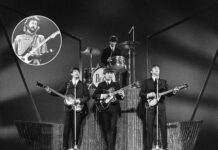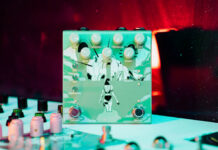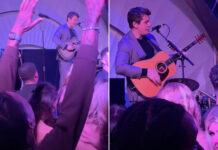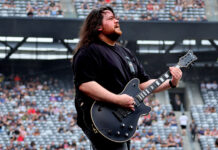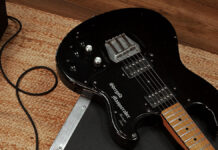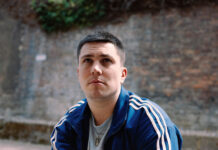
“I was never any good at chords, I always preferred to play the tune”: Peter Green on guitar, Fleetwood Mac and the Yardbirds
This interview was first published in 2007.
“I’ve only recently begun to understand what blues is really all about. I used to think that it was all about cotton fields and country blues – I was always fluffing around with stuff that I didn’t really understand. I couldn’t latch onto it all at first.”
Peter Green is sitting quietly in the corner of a hotel bar in the shadows of Tower Bridge. If you’ve met Peter over the last decade, then hearing him talking today – sharing anecdotes and confidently reminiscing about his musical life – you won’t be able to avoid help noticing a sharp contrast between this relaxed and lucid character and the noticeably introverted man you’d have encountered just over a decade ago at the time of his re-emergence in 1996 with the Splinter Group. Slightly portly and with only a frizz of white curls that hint at his long-haired glory days, Peter has the air of a kindly, benevolent uncle.
It’s hard to reconcile this unassuming person with the legendary guitarist who led such an astonishing career with Fleetwood Mac. Just two years after forming in the summer of 1967, the band was managing to shift more records than The Beatles and the Rolling Stones combined. Equally remarkable was the way that a hard-nosed blues outfit featuring an Elmore James aficionado transformed into Fleetwood Mac the world-straddling pop stars, producing hit singles like Albatross, Oh Well and Black Magic Woman. And then, for Peter Green, it all went wrong.
Maybe it’s the passage of time – after all, it’s been almost 40 years – but now the guitarist has no problem in reflecting on his darkest days. “I know that after I had taken LSD I was out of communiqué for a long time,” he begins. “But it wasn’t hard to be the way I was… I was ready to do it. I was worried about what I felt was this privileged position I had as a musician, and I didn’t like what was expected of me.
“If people asked me to play them something, I’d just say ‘No’. They’d say, ‘Get your hair cut’ or ‘Cut your fingernails’, and I’d just refuse. I suppose I was like a beatnik – but I liked the way I was. I liked having my fingernails long, even if I couldn’t play guitar; I didn’t need to play. I didn’t want to even think of myself as a musician.”
Butcher blocked
Peter Green’s initial guitar inspiration was his older brother Len, the first member of the Green family to get a guitar. For Peter, Len’s informal lessons were a welcome escape from his day job as an apprentice to a butcher in Putney.
“He taught me a bit, but I was never any good at chords,” Green remarks. “I always preferred to play the tune. I used to like Hank Marvin’s finer work, and my brother Michael and I learnt to play Apache – but he’d play the chords while I always picked out the tune.
Image: Redferns / Getty Images“I didn’t really want to play blues at first, but I used to go and listen to The Yardbirds at places like the Crawdaddy Club and the Marquee Club in Wardour Street, which made me want to give up the bass, and try and get that Eric Clapton style on guitar.
“I used to love watching Paul Samwell Smith, the Yardbirds’ bass player; he interested me because he looked a bit like a University teacher and always used to do this doubling-up thing at the end of numbers to bring them up to a climax. I was intrigued by everything about them. They seemed to attract a college crowd; sometimes they were a bit ragged, but it was a fabulous show.
“I’d seen the Stones in Richmond, but the Yardbirds were very different; they were all very clean, their guitars were new and their hair looked good, whereas the Rolling Stones always seemed to be dirty and dusty. Their music wasn’t that clever technically, I suppose, but for me it was a new high, a climactic thing that really seemed to be going somewhere.’
At the time Peter owned a Harmony Meteor semi-acoustic that had been given to him by the guitarist in one of his early bands. “It was a beautiful guitar,” he remembers fondly. At one point he’d actually converted the Harmony into a four-string bass, but inspired by Clapton’s playing he once again replaced the nut and bridge to return the guitar to six-string form. Clapton was only 18 months older than Green, but musically and professionally was already on another level. Legend has it that Peter would regularly grab the obliging Eric Clapton after Yardbirds gigs and absorb some playing tips.
Image: George Wilkes / Hulton Archive / Getty ImagesEquipped with his trusty Harmony, Peter then joined Peter B’s Looners, an instrumental outfit led by organist Peter Bardens, and soon he was playing legendary Mod hangouts like the Flamingo club in Wardour Street and the Ram Jam Club in Brixton. Without doubt, the experience was valuable – but more fatefully, the Looners’ personnel also included a lanky drummer called Mick Fleetwood.
Birds of a feather
In March 1965 the Yardbirds released For Your Love. Disheartened by the band’s sudden commercialism, Eric Clapton abruptly left to play with John Mayall’s Bluesbreakers. Some 40 years on Peter Green is understandably hazy about the precise sequence of events, but what is certain is that along with many others inspired by Clapton’s virtuoso playing, he too quickly became a Bluesbreakers fan. Crucially for Green, Clapton wouldn’t stick long with the Bluesbreakers, either.
“I still didn’t ever make any conscious decision to play blues guitar, but I’d seen Eric Clapton playing with John Mayall so much,” Green recalls. “Peter B’s Looners used to support John Mayall at the Flamingo club, and when I found out Eric was going to Greece [in the summer of 1965, when Clapton left the Bluesbreakers to perform in Greece with a band called The Glands – Ed], I went along to the Zodiac Club in Putney where I lived to try and get an audition. They had someone called Jeff Kribbetts playing guitar, and although I didn’t necessarily think that I could do a better job than him, I just wanted to have a go! He was doing these little blues phrases like the riff on My Babe, and I thought, ‘I can’t do that’ – but I also noticed that he had big fingers, and that encouraged me.’
Green eventually buttonholed John Mayall during the interval of a Bluesbreakers gig in August 1965. Mayall remembers it well: “Peter got up from the audience and came up to me angling for the job saying ‘Let me play. I’m better than he is,’” he laughs.
Peter Green with John Mayall. Image: Graham Wiltshire / Hulton Archive / Getty Images“He kept on doing this, each time becoming a bit more forceful, and because I was pretty much open to hearing anyone, I gave him a shot at it.” Green recalls the meeting differently. “John wouldn’t let me play that day but I was persistent, and eventually I answered his advert in the Melody Maker saying that he wanted a guitarist of the Buddy Guy or Otis Rush calibre. I went to his house in Lee Green and we had a little audition. He said, ‘Well, you’re the best I’ve heard since Eric’ – which was good because I was pushing the hell out of the strings trying to sound like him! I was a tremolo arm kid – I’d never had a guitar with one, but I was trying to get that same bendy effect.
“I was quite nervous stepping into Eric’s shoes. I worried that the band played too powerfully for me, or perhaps that John wouldn’t like me. But I ended up doing two or three gigs with John – Newcastle, Sheffield Mojo and I think Klooks Kleek in Hampstead – before Eric came back.”
Unbreaking blues
Clapton’s quick and unexpected return from his Greek odyssey in November 1965 understandably left Green bitterly disappointed, but revenge would be sweet. In June 1966, frustrated by the limitations of the Bluesbreakers, the mercurial Clapton left to form Cream. To Green’s delight this time the tables were turned, and he found himself being courted by an eager Mayall.
Determined to match Clapton’s sound, Green bought a sunburst 1959 Gibson Les Paul and a 50-watt Marshall amplifier with a single 4×12″ cabinet. His return to the band brought an immediate change in the Bluesbreakers sound: ‘The first time I used that guitar was when we playing Klooks Kleek, and John said, ‘So that’s your new weapon! You should do better with that,’ Peter laughs.
Image: David Redfern / RedfernsTowards the end of his tenure with John Mayall, Clapton had been increasingly stepping out of the traditional blues framework, with extended solos and the use of feedback. Green’s approach was far more precise, and his carefully constructed solos harked back to the time when he’d first practised Shadows tunes with his brother. Initially, the Clapton fans were angry at this new boy on the block who appeared to be usurping the man they called ‘God’. Soon, though, they began to accept that Clapton had a more than worthy successor.
Producer Mike Vernon echoed this sentiment when the band turned up at Decca’s West Hampstead studios to begin recording the Hard Road album. “I was expecting Eric,” Vernon freely admits, “But from the moment that Peter plugged in, I never had any doubts that he was going to be as good as Clapton within the Bluesbreakers framework. I think John already knew that Peter could play all the licks that Eric played, but he was going to do it his way – and his way was different.”
The Hard Road LP turned out to be every bit as accomplished as Clapton’s Mayall debut. Green supplied astonishingly eerie guitar on The Supernatural and some brilliantly biting licks on his reading of Freddie King’s Stumble and Someday After A While You’ll Be Sorry, but even more surprising were his vocals on You Don’t Love Me. Unlike Clapton, whose singing on the previous Bluesbreakers album was diffident, Green sang with real authority and conviction.
“I didn’t ever want to be a frontman, though,” Peter admits with a rueful smile. “All I wanted was to be a sideman like Buddy Guy when he worked with Junior Wells. I didn’t want to do vocals at all. It just came along by accident.”
Stepping out
The reason that Peter Green decided to leave the Bluesbreakers in June 1967, only a year after joining, remains a mystery. It wasn’t a personality clash: by this time John McVie and Mick Fleetwood were both in the band and had become firm friends with Peter. He also got on well with Mayall. But when Mayall thoughtfully awarded Green some studio time as a birthday present, he wheeled McVie and Fleetwood into the studio to record some tracks as a three-piece. It may be that Peter was irritated by use of a brass section on Hard Road, a move that to some diehard blues traditionalists signalled a capitulation to the evil forces of jazz. Whatever the truth, by the time Peter Green left the Bluesbreakers, Mick Fleetwood had already been sacked.
“He came around to see me and we got Fleetwood Mac together,” Fleetwood later reminisced. “We had no manager, so we did everything ourselves, got the van and equipment sorted out… Mike Vernon suggested we get Jeremy Spencer, who was playing in a Birmingham blues band called the Levi Set. We went up to see him, asked him to join and went straight into rehearsing for the Windsor Jazz and Blues Festival with Bob Brunning on bass.’
The band’s first album, Peter Green’s Fleetwood Mac, was released soon afterwards, and with the double whammy of Peter and Jeremy Spencer sharing the spotlight the group quickly became a popular club act. But from the beginning, Spencer’s anarchic approach to slide guitar was always at odds with Peter’s more structured approach to songwriting.
“He couldn’t play my tunes, so it was disheartening in a way,’ Peter admits. “When he joined we used to share the singing half and half, but because he couldn’t play on my songs, I only had bass and drums behind me. It was a bit empty.”
Image: Graham Wiltshire / Hulton Archive / Getty ImagesThe solution was not to dispense with Spencer’s services – his onstage antics and sense of fun served as a perfect antidote to Peter’s more studied approach – but to recruit a third guitarist. Danny Kirwan played for a London band that had supported Fleetwood Mac before. “It was Mick’s idea to get Danny in the band,” says Green. “He was playing a Watkins Rapier in this band Boilerhouse, and just sounded so good. He was a terrific player.’
Introducing a third guitarist wasn’t a problem. “We never played all at once,” Green explains. “Jeremy Spencer used to toddle off and leave us to it, which is why we had Danny Kirwan. At the beginning he was supposed to play piano – like Skip James, he thought – but he never did.”
Black Magic Woman was released early in 1968 and nudged the bottom of the Top 50, giving the band their first taste of pop fame, However, no one – least of all Green – was prepared for the runaway success of the band’s next foray into the singles chart. In October that year the band recorded Albatross, a wistful, laidback instrumental that echoed Santo And Johnny’s classic steel guitar showcase Sleepwalk and, once again, showed Peter’s love of pure melody.
“Jeremy didn’t play on that record,” notes Green. “I double-tracked the bass and did the slide guitar as well, playing a Stratocaster flat on my lap. When we did the video, Jeremy faked the slide part. In fact, I used a Hawaiian third string on my Les Paul as an aid for vibrato; it sounds like a Hawaiian guitar when the player’s left his slide at home! I bought it because that was only string the shop had that was the right gauge.”
Post-Albatross, more hits – Need Your Love So Bad, Man Of The World, Oh Well, The Green Manalishi – quickly followed. Not all of them, inevitably, were as Peter would have preferred: “I never really intended Oh Well to have the first section,” he complains, “I just wanted it to be the classical second side. I took the idea for the lyrics from that old blues song by Muddy Waters about, ‘Oh well, if I was a catfish…’”
Finding your feet
Less than two years later, the original version of Fleetwood Mac would be over and Green, the band’s undoubted leader, would spiral inexorably into a personal hell. His antipathy to touring and the trappings of success combined with the effects of too many acid trips left him paranoid and withdrawn. Though he had a couple of reunions with Fleetwood Mac in the early 70s and pulled himself together by the end of the decade, producing a handful of albums that showed glimmers of his talent, it wasn’t until 1997 that he truly re-emerged, making a series of albums with The Splinter Group over the course of some seven years and releasing the all-acoustic Robert Johnson Songbook in 1998. The latter, perhaps, revealed most strongly that Green’s mind was once more at ease with playing blues – something that he had always struggled to justify.
His deep love of the blues is evident when we ask who he’s currently enjoying listening to – it’s a predictably esoteric group.
“My favourite voice ever is this guy called Maxwell Street Jimmie, who was a busker on Maxwell Street in Chicago,” Green begins. “He played this demonic guitar and was a lovely, rough player. Some of his songs were tremendous, but he only made a few records.
Peter Green with John McVie of Fleetwood Mac. Image: Michael Putland / Getty Images“Then there’s Hop Wilson, a slide guitar player from Houston who used a twin-neck lap steel. He recorded a couple of singles calling himself Pap Hop, and wrote the song Black Cat Bone [Later covered by Robert Cray]. I love his album Texas Steel Guitar Flash. I’m also a great lover of gospel music at the moment – people like the Soul Stirrers, Pilgrim Travellers and the Swan Silvertones.
“I’ve always loved harmonica players – Hoodoo Man Blues by Jnr Wells with Buddy Guy is another of my favourite albums – but I’ve also been listening to a harmonica player from Chicago called Tail Dragger. I like the way his music kind of chugs along. It doesn’t ever build up to any sort of climax – he plays like he’s in a small club where there’s an audience that wants to talk and he’s trying not to make too much noise. I’ve been listening to a lot of world music recently, too, and I just bought this Vietnamese banjo which has only got two strings. I love the weird sound it makes!”
So, Vietnamese banjos aside, will we see Green playing live again? It’s impossible to say. Currently, he’s spending time in Sweden, indulging his love for fishing on a lake near his girlfriend’s house. “I feel good in myself but at the moment I can’t see myself going back to playing full time,” he admits.
Image: RIchard Ecclestone / RedfernsPeter also seems to have attained a humorously philosophical attitude to the money and management problems that caused him so much torment in the past, though his words do seem to echo the let’s-give-it-all-away attitude that pervaded his split from Fleetwood Mac. “Once you have record sales you do have to accept money – but my manager found a way out of it by not paying me,” he chortles. “So maybe now all I need is a really good manager who won’t give me any money!”
One final question before we go. Once, Peter Green said that, in his opinion, people can’t really play the blues unless they’d actually experienced them. Does he still feel that way?
“Everyone gets the blues, whether they’re rich or poor,” he points out. “I’ve always known that to be born rich must give someone terrible blues – their whole life must feel as though it’s a joke.” He chuckles. “When I was a kid, I used to think that the blues was just all about the boring sides of life, like school and work. I used to get the blues about having to do my homework!”
For more features, click here.
The post “I was never any good at chords, I always preferred to play the tune”: Peter Green on guitar, Fleetwood Mac and the Yardbirds appeared first on Guitar.com | All Things Guitar.
Source: www.guitar-bass.net

